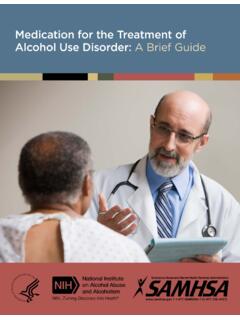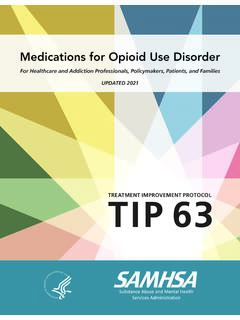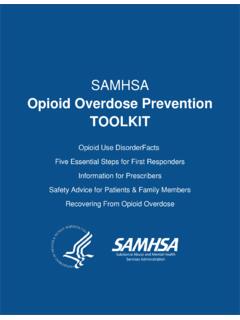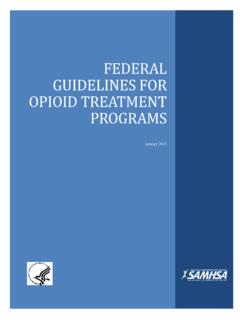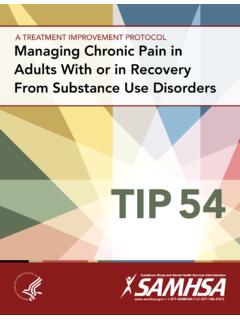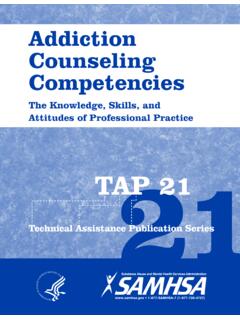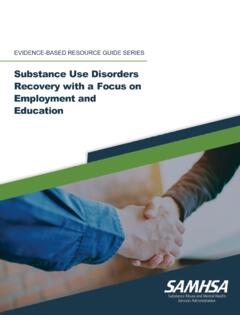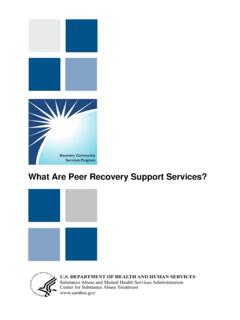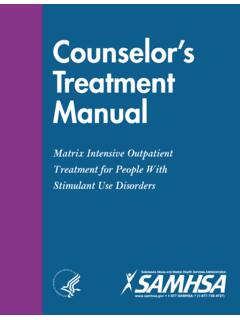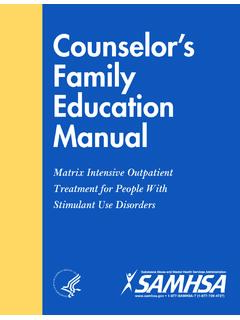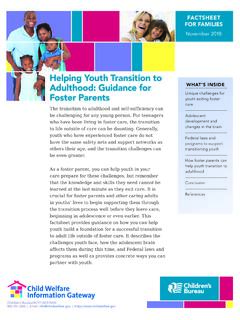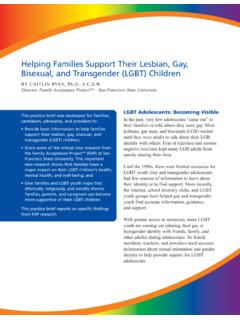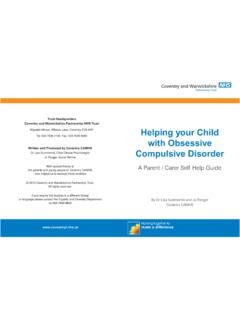Transcription of A Practitioner’s Resource Guide: Helping Families to Support …
1 A PrActitioner s Resource Guide: Helping Families to Support Their LGBT ChildrenAcKnoWLedGeMentsA Practitioner s Resource Guide: Helping Families to Support Their LGBT children was prepared by Caitlin Ryan, PhD, ACSW, Director of the Family Acceptance Project at San Francisco State University under contract number HHSP233201200519P for SAMHSA, views, opinions, and content of this publication are those of the author and do not necessarily reflect the views, opinions, or policies of SAMHSA or doMAin noticeAll materials appearing in this publication are in the public domain and may be reproduced or copied with-out permission from SAMHSA.
2 Citation of the source is appreciated. The publication may not be repro-duced or distributed for a fee without the specific, written authorization of the Office of Communications, AccessThis publication may be downloaded or ordered at Or call SAMHSA at 1-877-SAMHSA-7 (1-877-726-4727) (English and Espa ol).recoMMended citAtionSubstance Abuse and Mental Health Services Administration, A Practitioner s Resource Guide: Helping Families to Support Their LGBT children . HHS Publication No. PEP14-LGBTKIDS. Rockville, MD: Substance Abuse and Mental Health Services Administration, of Contentsintroduction 2critical role of Families in reducing risk & Promoting Well-Being 4 Helping Families decrease risk & increase Well-Being for their LGBt children 8increasing Family Support : How to Help right now 11resources for Practitioners and Families 12endnotes 13 references 142 A Practitioner s Resource Guide.
3 Helping Families to Support their LGBt childrenIntroductionSince the early 1990s, young people have increasingly been coming out or identifying as lesbian, gay, and bisexual, and more recently as transgender, dur-ing adolescence. This coincides with greater awareness and visibility of lesbian, gay, bisexual, and transgender (LGBT) people in society, the media, schools, congregations, and communities. More widespread access to information about sexual orientation, gender identity, and LGBT resources through the internet has contributed to significant changes in how children and adolescents learn about LGBT people and their lives.
4 And increasingly, this has helped young people come out at much earlier ages than prior generations of LGBT adults. (For information about sexual orientation and gender identity, see Definitions on the following page.)Coming out at earlier ages has important implications for how practitioners work with children , youth , and Families , how they educate parents, Families , and caregivers about sexual orien-tation and gender identity, and how services are provided to LGBT children and adolescents. Historically, services for LGB youth and later for transgender youth were developed to pro-tect them from harm, including from parents and Families that were perceived as rejecting or incapable of supporting their sexual minority children .
5 As a result, services evolved over several decades to serve LGBT adolescents either individually like adults or through peer Support , and not in the context of their Families (Ryan, 2004; Ryan & Chen-Hayes, 2013). Even though Families , in general, play a critical role in child and adolescent development and well-being, and connections to family are protective against major health risks (Resnick et al., 1997), until recently little was known about how parents reacted to their LGBT children from the perspective of parents and caregivers (Bouris et al., 2010; Diamond et al., 2012; Ryan, 2010) or how they adapted and adjusted to their LGBT children over time.
6 As a result, many practitioners assumed that little could be done to help par-ents and Families who were perceived as rejecting to Support their LGBT children . So few practitioners tried to engage or work with these Families (Ryan & Chen-Hayes, 2013). Nev-ertheless, earlier ages of coming out coupled with emerging research which indicates that Families of LGBT adolescents contribute significantly to their children s health and well-being call for a paradigm shift in how services and care are provided for LGBT children and adolescents (Ryan, 2010). This new family-oriented approach to services and care requires practitioners to proactively engage and work with Families with LGBT children and adolescents.
7 This includes providing accurate information on sexual orientation and gender identity for parents and caregivers early in their child s development; engaging, educating, counseling, and making appropriate referrals for Families with LGBT chil-dren; and in particular, Helping parents and caregivers who react to their LGBT children with ambivalence and rejection understand how their reactions contribute to health risks for their LGBT children (Ryan & Chen-Hayes, 2013).The overall objective in Helping Families learn to sup-port their LGBT children is not to change their values or deeply-held beliefs. Instead, practitioners should aim to meet parents, Families , and caregivers where they are, to build an alliance to Support their LGBT children , and to help them understand that family reactions that are experienced as rejection by their LGBT child contribute to serious health concerns and inhibit their child s development and well-being (Ryan & Diaz, 2011; Ryan & Chen-Hayes, 2013).
8 Research findings that show the critical role of family acceptance and rejection and earlier ages of coming out call for a paradigm shift to serve LGBT children and adolescents in the context of their of Resource GuideThis Resource guide was developed and is being disseminated throughout health and social service systems to help practitio-ners who work in a wide range of settings to understand the critical role of family acceptance and rejection in contributing to the health and well-being of adolescents who identify as lesbian, gay, bisexual, and transgender. This includes practi-tioners who work in primary care, behavioral health, school-based services, family service agencies, homeless and run-away programs, and foster care and juvenile justice settings.
9 Its intent is to help practitioners implement best practices in engaging and Helping Families and caregivers to Support their LGBT children . The family intervention approach discussed in this guide is based on research findings and more than a decade of interactions and intervention work by the Family Acceptance Project (FAP) at San Francisco State University with very diverse Families and their LGBT Orientation a person s emotional, sexual, and/or relational attraction to others. Sexual orientation is usu-ally classified as heterosexual, bisexual, or homosexual (lesbian and gay), and includes components of attraction, behavior, and identity (Laumann et al.)
10 , 1994). Sexual orien-tation is expressed in relationship to others to meet basic human needs for love, attachment, and intimacy (Institute of Medicine, 2011). Thus, young people can be aware of their sexual orientation as feelings of attachment and con-nection to others before they become sexually active. Gender Identity a person s internal sense of being male, female, or something else. Gender identity is internal, so it is not necessarily visible to others. Gender identity is also very personal, so some people may not identify as male or female while others may identify as both male and Expression the way a person expresses their sense of gender identity ( , through dress, clothing, body movement, etc.
